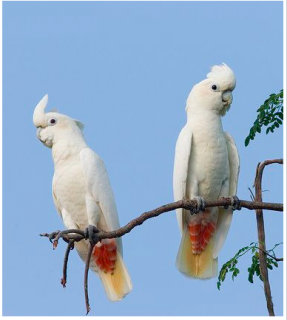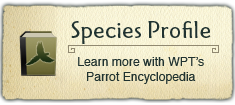Project Regions:
Red-vented Corella |
|
|
Collaborators/Funders
European Endangered Species Programme
Red-vented Corella numbers less that 1200
The Red-vented Corella or Philippine Cockatoo (Cacatua haematuropygia) is classified as Critically Endangered in the wild.
Project and progress : WPT sent an EEP Coordinator to work in the Philippines for the protection of the species:
- Funding flights for travel to and from the area
- Aiding, observing and evaluating local captive populaton
Outcomes: The World Parrot Trust, from 1994 to 1995, assisted EEP (European Endangered Species Programme) Coordinator Marc Boussekey's crucial work in the Philippines by providing much needed funds for flights to and from Palawan. His goal on the trip was to observe some of the latest viable populations of cockatoos, observe and evaluate the local captive population of the species, and to meet with Philippine partners and members of the SagipKatala (Save the Cockatoo) movement. From there, an intensive species conservation programme, the Philippine Cockatoo Conservation Program (PCCP) was begun by the Katala Foundation. By 2005 the organisation began to plan and build the Katala Institute for Ecology and Biodiversity Conservation, designed as a centre for environmental education, research and possibly captive breeding for reintroduction.
Wild population: 650-1120
Where found: The Red-vented Corella is restricted to Philippines where it once was common, now on Palawan Islands and the Sulu Archipelago.
History: The Red-vented Cockatoo or Corella, Cacatua haematuropygia, is native to the Philippines. It was once common, as recently as the 1950s, but has since undergone a rapid decline since which has left a population of under 1200 individuals. Extensive deforestation within its range and trapping for the wild bird trade has left this species Critically Endangered. Because of conservation efforts the population on Rasa Island near Palawan has increased from 20 to 200 in ten years (Widmann and Widmann 2008, Anon. 2010). In other areas declines have unfortunately continued, with extinctions in some.
Threats:
- Loss of mangrove lowland habitat
- Trapping for the wild bird trade
- Persecution as a crop pest
- Hunting for food
- Outbreak of Psittacine Beak and Feather Disease (PBFD)
- Typhoons
Ecology: The Red-vented Cockatoo is seen in lowland primary or secondary forest and mangrove, with occasional forays into cultivated areas. Its wild diet includes seeds, fruit, nuts, flowers, the bark of some trees, and berries. This bird is noisy and fairly conspicuous, gathering in groups to feed and roost. It forms larger groups outside of the breeding season. Individuals are said to escape winged predators by rapid, precise flying techniques.
Project Updates
- PsittaScene Vol. 13.4, Nov. 2001
- PsittaScene Vol. 7.4, Nov. 1995
- PsittaScene Vol. 5.2, May 1993
- PsittaScene Vol. 4.2, May 1992
WPT-sponsored research:
Conservation program for the Philippine Cockatoo in situ and ex situ aspects
Other publications:
Google scholar - Cacatua haematuropygia


































